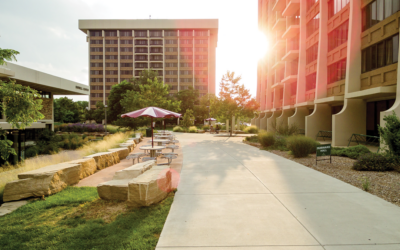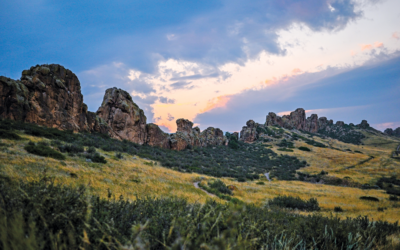Those who organize rodeos get it: It’s fun to watch cowboys ride a bucking animal the size of a pickup truck.
“It’s a terrific way to end the rodeo,” says Jason Bain, rodeo chairman for Cheyenne Frontier Days. “It’s a real crowd pleaser.”
But there are many other parts of a good old-fashioned rodeo. If this is your first rodeo—as in, you’re going to one of the rodeos that’ll take place this summer in Northern Colorado and Cheyenne, Wyo.—or you just want to learn how a rodeo works, read on.
Ropers and racers
Breakaway, team and tie-down roping measure a cowboy or cowgirl’s skill as they chase a runaway calf, rope it and, with the exception of breakaway, immobilize it. In barrel racing, cowgirls navigate their horse around three barrels in a cloverleaf pattern before racing back to the start.
These timed events are not only competitive, but they also show the audience real-life skills needed on a ranch, says Rebecca Peter, who oversees the Mountain States Circuit Finals hosted at The Ranch Events Complex each October and assists with the Larimer County Fair PRCA Rodeo. Team roping keeps a calf still so they can administer shots, for instance, and bronc riding evolved from taming and breaking in wild horses.
“I think people come for the entertainment side of it,” Peter says, “but there are a lot of people who aren’t familiar with that way of life.”
Bulldoggers and hazers
In steer wrestling (also called “bulldogging”), a 600-pound steer is wrestled to the ground by a cowboy known as a “bulldogger.” The steer gets a head start, and the bulldogger must ride up to it on horseback, get off the horse, grab the steer by the horns, tackle it and get its legs facing the same way as its nose. The bulldogger with the fastest time wins.
To keep the steer running in a straight line, a “hazer,” or a cowboy on horseback, rides on the other side of it. The hazer keeps the steer on course, allowing it to be caught and wrestled faster.
Bull riders
Memorialized in songs such as “Hooked on an 8 Second Ride,” the cowboys who ride bulls and broncs have long held the brightest spotlight, Bain and Peter say. The all-or-nothing nature of it (hang on with one hand for eight seconds or you don’t score), plus the dangerous dance between the bucker and the cowboy, thrills first-timers and fans alike. Scores are based on style, both from the cowboy and the bucker.
Bullfighters
Don’t call them clowns. Though they paint their faces like a birthday party entertainer, that’s where the similarity ends. They’re more like Secret Service agents for cowboys, as it’s their job to protect the riders from an angry bull or bronc once they are bucked off, Bain says. Sometimes this means getting in the bull’s way.
“The bulls just barely miss them all the time,” Bain says, “and that might be on purpose.”
Bain says that in good fun, and yes, part of bullfighting is the fun. They also compete in their own events where they’re scored on how well they evade a bull for a minute or so. But it’s also a serious business of distracting the bull and drawing them away from a fallen competitor.
“They’re the most athletic guys in the arena,” Bain says of the bullfighters, who are sometimes called “cowboy protection.”
Barrelmen
The barrelman is somewhat like a bullfighter, but he generally swaps the athleticism for comedy. The barrelman dresses like a bullfighter and hangs out in a barrel for protection and fun. The barrelman usually wears a microphone, heckles the crowd and gets heckled in return by the announcer, but it’s also his job to ensure everyone else is safe, Bain says.
“They can really make a difference in a rodeo,” Bain says. “It makes for a much more enjoyable time.”
Pickup men
The two men on horseback who rush in to safely dismount a cowboy off his horse after a bareback race or saddle bronc ride are called “pickup men” or “pickup riders.” They also come to the rescue when someone is bucked off a bull or bronc, herding the animal away from the contestant.
Mutton bustin’
Kids roughly ages 7 or younger who meet a weight limit ride the back of a runaway sheep and hang on for as long as possible. The kids wear a helmet and protective clothing, so it’s considered safe.
Animals (also called “roughstock”)
The animals are just as important to a successful rodeo as the cowboys and cowgirls, Bain and Peter say. You may think a cowboy would want an easy bull or bronc, but you’d be dead wrong. Half of a rider’s score comes from the bucking animal, so if a bull or bronc decides to be gentle, that rider won’t make the finals.
“You want one to buck hard,” Bain says.
Points are accumulated for the animals as well as the riders, and the best are crowd favorites. There are even animals in the ProRodeo Hall of Fame.
The best animals get their stock contractors major deals with big rodeos such as the ones in Cheyenne, Greeley and even the National Finals Rodeo. That’s why one of the running jokes by rodeo insiders is that the animals are treated better than the cowboys who ride them.
“They’re just as much of an athlete as the contestant,” Peter says. “They have to perform their job in order for the contestants to do well.”

Gage Hesse steer wrestling at the 2024
Mountain States Circuit Finals. Photo by Tanya Hamner.
The life of a cowboy
Gage Hesse went to Western Texas College to learn how to be a welder. He graduated with a career as a rodeo cowboy.
This summer he’ll be on the road trying to wrestle steers three times his size to the ground in seconds. It’s a long, dusty road, with all the clichés in country music songs, but many of them are true. Aches and pains are a constant companion, including the one in his heart, when he misses his longtime girlfriend, parents, brother and grandmother.
It’s also part of what he enjoys about the life of a traveling cowboy. He considers himself lucky, and not just because a minor knee problem and a broken wrist are the only two injuries he’s had in his career. He’s 26.
“Knock on wood,” he says. “I’ve already seen every state this side of the Mississippi.”
In the heat of the summer, when the season peaks, Hesse will compete so often that he may go to two rodeos in a weekend. Occasionally, around July 4, he’ll go to three.
“Sometimes you’ll be in a place all week,” he says, “but sometimes, you’ll get there 20 minutes before you’re up.”
Hesse lives in the Keenesburg area, where he grew up, and his father coached rodeo. He even showed cattle in the local 4-H program and did a little team roping, so it might seem like he was born to be a cowboy. But Hesse preferred tackling humans to cattle, playing linebacker for Weld Central High School, and he didn’t take part in rodeos until he went to college and began hanging out with other cowboys. He liked the sport and his friends so much that he walked onto the rodeo team in his freshman year.
It’s not an easy sport or a steady way to make a living. Hesse won $42,000 last year and was ranked 45th in the Professional Rodeo Cowboy Association, a good bump from 2023, when he won $30,000. In 2019, his first year, he won $4,500. However, those purses don’t include expenses. He is sponsored by the Greeley Stampede, which he says he’s grateful for.
That’s why Hesse finished his welding degree. He spends half the year working for Huwa Enterprises in Keenesburg. He says they give him health insurance and “let me come and go as I please.”
Hesse enjoys the life of a cowboy. He’s not ready to give it up anytime soon. He also knows it isn’t forever, and in some ways, he’s grateful for that.
“Saying goodbye after a few days at home,” he says, “is the hardest part.”







